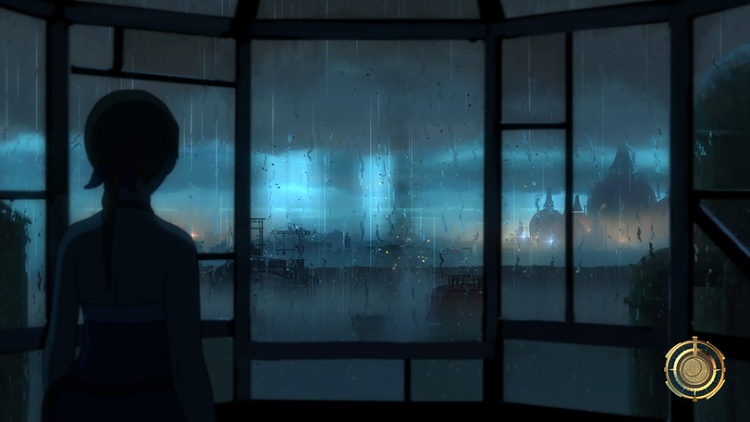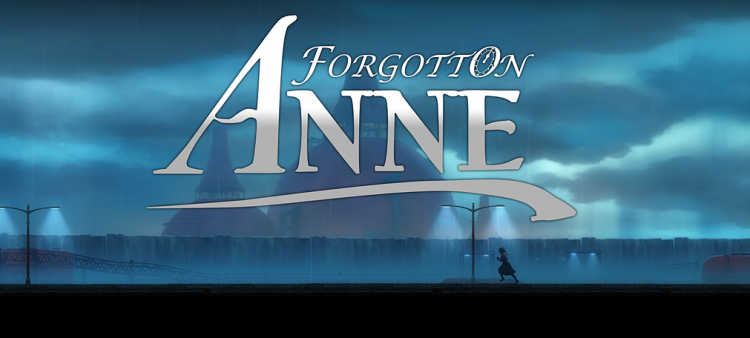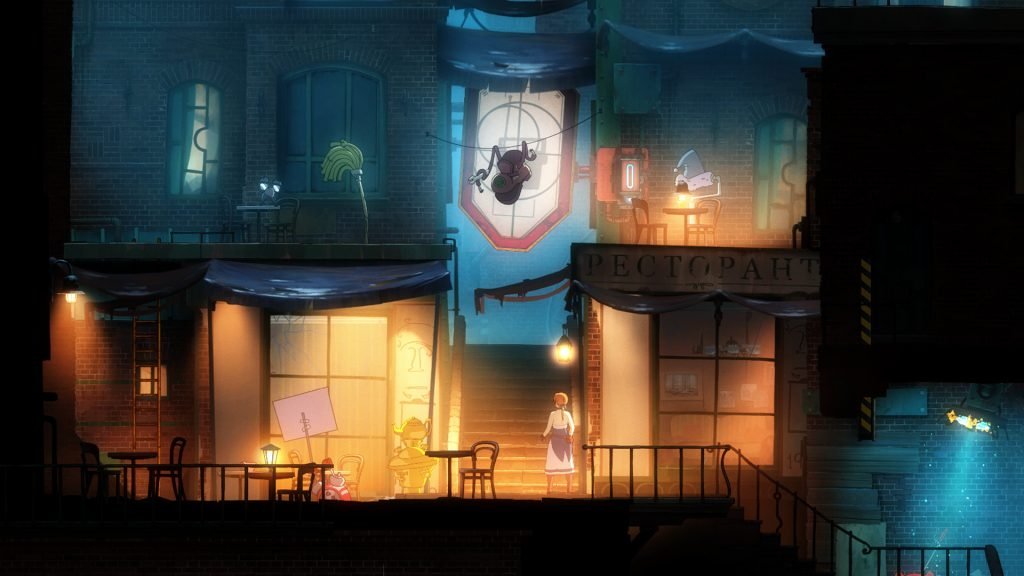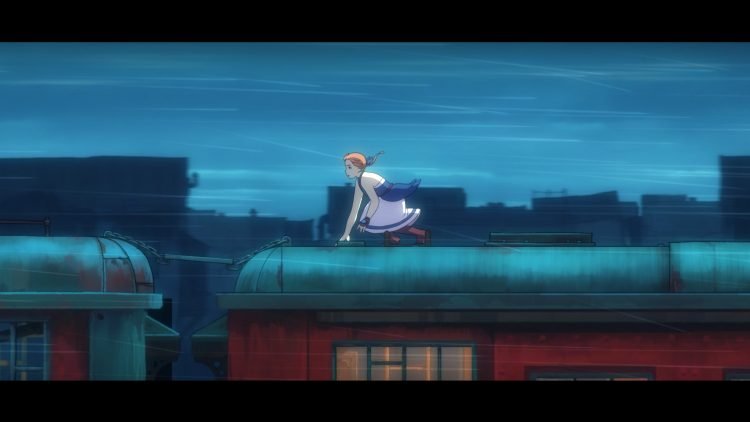Forgotten Anne is made by ThroughLine games, published by Square Enix. It’s described as a cinematic, “2.5D” game. It combines puzzles, logic, and a little bit of platforming into a thrilling, fantastical story where choices matter. It’s beautiful, it’s fluid, it’s charming, and it’s also probably one of the best games to come out this year.
Game Name: Forgotton Anne
Platform(s): PC (reviewed), also on PS4 and Xbox One
Publisher(s): Square Enix
Developer(s): ThroughLine Games
Release Date: May 15, 2018
Price: $19.99
There’s a lot of reasons to like Forgotten Anne, and for the sake of preserving the experience for new players, I’ll be focusing on the beginning of the game only. Even so, be warned: The rest of this article is not 100% spoiler-free. If you’re looking to get the full experience of playing this game, turn back now and try it yourself.
The Good
The first thing players see from Forgotten Anne is a cutscene. The viewer sees a bustling city, rife with normal, busy people. It’s a scene we’ve seen so many times before, in cartoons, games, and movies, and for quite a few of us, it’s everyday life. This beginning cutscene is meant to introduce the game, and we’re lulled into a sense of security as we sit back and watch it unfold. What will be the focus of this game? The homeless person, forgotten and stepped over by the rushing crowd? The man on his cell phone, hurrying through a crosswalk? Will it be the person we see putting on a single sock as he prepares for his day?
It’s none of these, at first. In fact, the focus of this introductory cutscene isn’t a person at all. It’s a sock.
What’s so striking about this cutscene is that it remains engaging, all throughout its duration. There aren’t any words at first, yet the story is communicated: This singular sock was forgotten, and magically transported to a different realm, a realm full of smoke and machinery and other, talking objects. Sometimes, cutscenes feel like a barrier to gameplay, and one can easily find themselves just wishing it would end sooner. These cutscenes are different. Each one is beautifully animated in a style I can only describe as “classic animation,” the likes of which we’ve seen in Studio Ghibli films and movies such as Beauty and the Beast. Even the inanimate objects are animated, given their own personality and life and methods of movement. You’re drawn in by the intricate design and smooth, stunning colors, and before you know it, the cutscene is over, and you’re watching your sock friend get introduced to the world of lost objects.
This game also stands out as a result of its layout. Forgotten Anne’s website describes it as “2.5D,” but for those unfamiliar with the concept, it’s worth explaining. Your standard two-dimensional adventure game will feature platforms of different heights, obstacles to jump over, and buttons to run right or left. They might include a ladder or two if you’re lucky, or some flying power-up. Forgotten Anne went the extra mile and created what is virtually a two-dimensional game with depth. You can move side-to-side, jump up or climb down, but you can also move to the foreground or background where the scenery allows. Even when it doesn’t allow these movements, the backdrops provide the illusion of depth, despite the fact that we know it isn’t present.

Speaking of backdrops: Holy cow. The development team absolutely blew this challenge out of the water. Every tiny detail about Forgotten Anne is visually stunning, be it the backgrounds, the characters, the minuscule details about stature and movement and colors. At the beginning of the game, Anne’s dwelling has lost power, and as you search for a power cell, she appears in silhouette against a misty-blue background that gives the illusion of darkness, the absence of light, without actually being dark. Despite the fact that the character can’t see, we, the players, can, and what we’re seeing is gorgeous. This is a feature games often forget as they seek complete immersion: In order to tell a story, the people listening and playing must be able to understand. This means players must be able to see the characters and their environments, hear them, and understand what they’re saying. That’s a tall order, yes, but it serves as a reminder that there’s a reason storytellers still have jobs. It’s difficult, and it’s also so, so worth it.
I would be amiss to talk about the design of this game without touching on the sound design. Forgotten Anne’s sound techs deserve a medal. Sound is often overlooked in most games unless something goes wrong, at which point everyone notices it, and everyone comments on it. If they do their job right, often times, no one will say anything at all. Indeed, I think they did everything right, because even though I was purposefully listening for the soundtrack and sound effects, I still swept away in the majesty of it all, with how seamlessly the sound integrates with every other aspect of the game.
One of my favorite small details of this game occurs in the beginning after Anne restores power to her home. Master Bonku, the authority of the Forgotten Realms, contacts her through the use of a “magic mirror.” (It’s in quotes because if we want to get technical, the mirror is powered by some form of electricity or electricity substitute, so perhaps it isn’t truly magic.) The sound designers could have gotten away with simply having his voice play as normal. They could have had no voice at all, for that matter. What they actually did was play Master Bonku’s voice with a quality reminiscent of an old-fashioned radio: Grainy, far away, and clear enough to make out, but still keeping noticeable interference. When Anne responds, as a character physically present in the scene, her voice has none of that interference, and that obvious difference makes the whole scene that much cooler. The fact that the magic energy – anima – of this world still has limitations and flaws makes it that much cooler.
None of this was required. None of these tiny, minuscule details was required. No one told ThroughLine Games to make a movie inside their game. No one told them to make their cutscenes look like the actual gameplay. No one made them create cute, unique animations for every Forgotling, to put Forgotlings in the background and allow them to be distilled at the whim of the player, no one made them fully voice their game. They did it anyway, and what they were able to do is stunning, and worth commendation.
The Bad
It feels selfish to say I wish I had more, but I feel that’s the only thing I can really say this game lacks. In conversations, you’re given two different options, and often, neither of them are exactly what you want. Yes, it forces you to choose, and it streamlines the story arcs. Yes, I still wish I had at least one more choice.
Perhaps I’m spoiled: I got used to Pyre, which has a wide array of dialogue options that allow you to make your character react in the way very close to what you want. Choices that impact gameplay are still an uncommon concept in games, and games that do it deserve commendation to the highest degree. Still, the choices Forgotten Anne presents are some of the most difficult I’ve had to make in games, especially when all I want is to be kind to these poor, overworked Forgotlings, or to question the rebel scarf one more time. Sometimes I’m lucky and a dialogue option will be exactly how I would react. Other times, not so much, but I persevere.
One more thing, I’ll make it brief: The exploration isn’t always intuitive, but that is likely by design. I assume the idea is that you have to decide where you want to go, no one leads you there. Still, I wish there was at least a little bit of a hint on what area would be better to visit first when one meets a fork in the road. At one point, I had an objective on the upstairs floor and one on the downstairs floor and chose to go upstairs first. By the time I realized I had made a mistake, I was locked into another brief tutorial, couldn’t go back downstairs, and had to fly out of the building, to the ground, and then go back into the building. However, on the other hand, I really appreciate the freedom of choice. It’s a sticky situation.
The Ugly
I’ll be forthright: The controls are a bit tricky. At times I feel like I’m tangling my fingers to press Shift, A, then CTRL as well to use my wings. Sometimes I need to click and hold a lever, then reach over that hand to press A or D to move it. Could this be user error? Absolutely. Is it still kind of a pain to have a major motion control be assigned to CTRL by default? Well…
The good news is that these issues with controls haven’t made Forgotten Anne unplayable. The small adjustments I make to learn to play are very much worth it, and I’m genuinely enjoying the game. The better news is that this is honestly my only grievance with this game. I honestly can’t think of anything else.
You can find Forgotten Anne on PS4, Xbox One, and Steam. For more information, visit their website, here.
Review Disclosure Statement: Review copy of Forgotton Anne was provided to us by Square Enix for review purposes. For more information on how we review video games and other media/technology, please go review our Review Guideline/Scoring Policy for more info.
Affiliate Link Disclosure: One or more of the links above contain affiliate links, which means at no additional cost to you, we may receive a commission should you click through and purchase the item.
Summary
In conclusion: If I tried to touch on everything I loved about this game, it would be twenty pages long and no one would read it. Please, if you have a place in your heart for a new story-driven game, give Forgotten Anne a try. Games like this don’t come around very often, and it’s worth it to enjoy them while they’re here.
A stunning game on every front and it deserves the praise it gets.




